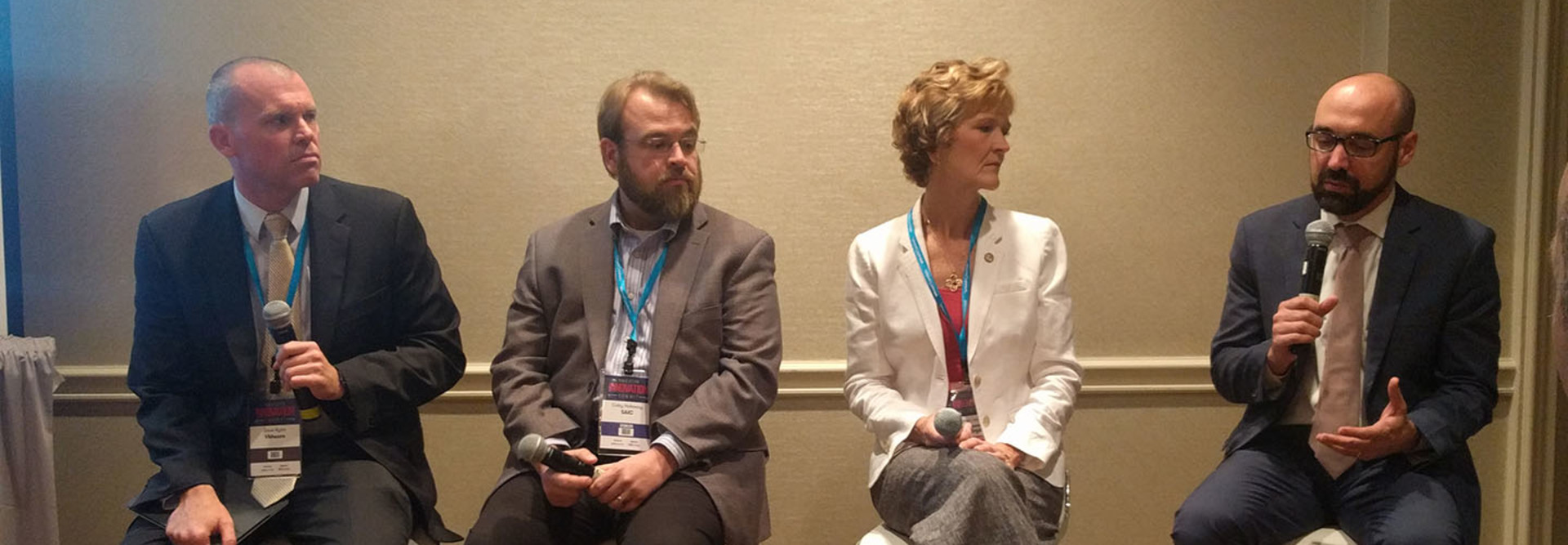State and Industry Officials Talk the Benefits, Challenges of Digital Transformations
Digital transformations aren’t just coming to government: they’re here — and here to stay.
“When we talk about technologies like software-defined data centers and cloud computing, these things aren’t the future, these things are here today,” Dave Ryan, senior director for public sector alliances at VMware, said during the Digital Transformation panel at the FedScoop Public Sector Innovation Summit in Arlington, Va., on Wednesday.
Coby Holloway, vice president of cloud computing and business transformation for defense contractor SAIC, says the digital environment in state and local agencies is seeing a massive shift. That shift is driven by the need to modernize legacy systems, as well as the desire from within IT departments to move toward software-defined infrastructures and migrate more data to the cloud.
“There are a few technologies that we’re really seeing massive adoption of, and it’s all in the software-defined space,” says Holloway, calling software-defined data centers the “fabric that IT needs” to create a lot of data center services and, in turn, craft new business services for IT consumers.
The Business and Service Benefits of New Technologies
With a shift toward software-defined infrastructures comes some major benefits in making governments more agile.
“One of the biggest efficiencies is the ability to compose and recompose IT services to technical services at the data center level. This is needed to provide the business services that the IT consumers need at the end of the day,” said Holloway. “What has historically taken weeks or months to deliver a piece of infrastructure, operating system, etc., is now able to be delivered in minutes because of the infrastructure retooling that comes with the software-defined infrastructure.”
Karen Jackson, Virginia’s secretary of technology, also cited the ability to access data analytics as a significant potential benefit of digital transformation.
“States have some of the largest amounts of data around,” she said. “Most of the data we have is very stove-piped right now, so we see this migration to the cloud and this migration to enhanced platforms as a way for us to be able to better share data, better analyze data. Hopefully, at the end of that, we’ll be able to turn it into better citizen outcomes through the matchup of different programs and being able to tweak that based on empirical data.”
The Challenges Facing Federal, State and Local IT Adoption
But as agencies look to IT transformations, Ryan notes that there are challenges inhibiting agencies from adopting these solutions today, “whether it be budget, solutions of the past, or workforce.”
Virginia, for instance, is approaching a digital transformation and, with a 13-year contract on the cusp of expiring, the government is peeking over the horizon into how it will deliver the future of government services.
“It’s not just about finding out what’s out there and available today, it’s about trying to figure out where the public is going to be a couple of years from now — or three years from now — and how to restructure everything we’ve got in the environment to be able to accommodate that,” Jackson said.
While the state has already launched some modernization initiatives related to storage and moving to a Google-based email platform, a changing public is informing its outlook.
“It really is a challenge when you’re trying to satisfy citizens who are increasingly mobile; 24/7 they want to be able to interact with you where they are, when they are … Then we’re trying to balance the fact that we have an aging workforce,” said Jackson, adding that 50 percent of IT workers for Virginia are at (or close to) retirement age. “The millennials and digital natives that are coming in have a completely different work ethic; they have a completely different view of the work day.”
The policy environment is also proving to be an issue for the state.
“As you start to move things into the cloud, privacy issues come up very quickly. We’ve been going through a long process of identifying challenges in our own code that will prohibit the sharing of data, even within agencies, some of which dates back to the 1930s,” Jackson said.
Moreover, the cultural shifts necessary to introduce new technology can be some of the largest barriers to change.
“You have to retrain people. You have to get them comfortable with technology and the fact that the rules might change, but that they will change for the better,” said Holloway. “Dealing with legacy processes, legacy cultural barriers and internal communication, and breaking down siloes: these are the things that are the hardest part of new technology adoption and disruptive technology.”
Addressing IT Barriers Through Dialogue
In addressing these cultural barriers and possible pushback from both citizens and the IT workforce, however, the experts advocate for a better dialogue around digital transformations —discussions that will pinpoint exactly how they will improve government services and efficiencies.
“Creating for [people reluctant to technology] that safe place where you can make the technology real to them, show them that this is not something to be scared of, and then start to instill on both sides solid risk management principles” is important, said Montgomery County Chief Innovation Officer Dan Hoffman. “You have to make these decisions from both ends with sound, risk-based, pragmatic conversation as opposed to fear-based policies or obstinacy.”









